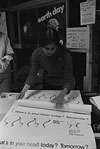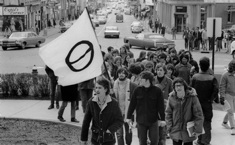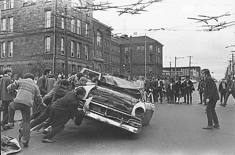Teaching the Article
Exercise 3
All of the materials associated with this exercise are available for download.
Earth Day and the Environmental Movement
The modern environmental movement captured the nation’s attention in 1970 when millions of Americans took part in the first Earth Day. Congress recessed for the day, Time magazine designated the environment as “the issue of the year,” and events at schools, colleges, neighborhood parks, and state capitols focused new attention on the fate of the Earth.
The forces that propelled the environment into the limelight of American public life had been building since the 1950s. The nation’s post–World War II economic boom had allowed many people more time to focus on quality of life issues. Since the publication of Rachel Carson’s 1962 book, Silent Spring, which highlighted the potential human and ecological threats posed by pesticides, Americans had grown warier of postwar technologies such as chemicals and plastics. The science of ecology was raising both scientific and popular concern for an interconnected and fragile environment. A series of environmental disasters captured national headlines in the late 1960s: the polluted Cuyahoga River in Ohio caught fire in 1969, an oil derrick off the coast of Santa Barbara suffered a blow-out that same year, and severe air pollution plagued many metropolitan areas, including Los Angeles and New York. And the environmental movement drew on the energy of other political movements that charged American politics in the late 1960s.
It is difficult to conceive of Earth Day without the civil rights movement, the women’s movement, or the antiwar movement. The emerging environmental movement both borrowed from and contributed to the range of social protest movements that reshaped American politics in the 1960s and 1970s. Earth Day was conceived of by Senator Gaylord Nelson, a liberal Democrat from Wisconsin and a strong advocate for an expanded role for the government in environmental protection. But Earth Day activities were coordinated by a group of students—led by Denis Hayes, a Harvard Law School student—who were often more critical and frustrated than were politicans with the government’s role in environmental degradation. The historian Adam Rome has identified three key constituencies that joined together to make Earth Day a pivotal event and to give the modern environmental movement its political traction: liberal leaders of the Democratic party, increasingly proactive middle-class women, and students aligned with antiwar activism and those drawn to the counterculture. A wide range of protest activities—including demonstrations, marches, speeches, and vigilante activities—shaped Earth Day, and the event brought together many Americans. This confluence of events, people, and movements represented the uncertain connections between environment, economics, government, and justice important to the emerging modern environmental movement.
The first Earth Day is often singled out as a pivotal moment in the history of American environmentalism. Historians have emphasized that it marked the rise of a new populist concern for the environment. It signaled a shift from focusing on earlier conservation issues—such as park and wilderness protection and natural resource management—to a new generation of environmental issues—such as air and water pollution, toxic chemicals, and other threats to human health. Earth Day was also the springboard from which Congress and the Nixon administration launched a wide array of legislative initiatives that dramatically expanded the federal government’s responsibilities for environmental protection. Indeed, in the early 1970s, Congress passed major legislative initiatives including the National Environmental Policy Act (1970) and the Endangered Species Act (1973), and amended earlier clear air and water legislation.
Earth Day and this flurry of legislative initiatives highlight a riddle central to the emerging environmental movement in the 1960s: How and why did the diverse protest activities that distinguished Earth Day—activities that as often challenged the government as supported it—get channeled into such an effective legislative campaign aimed at reforming and expanding the government’s role in environmental protection? Try to decipher that riddle for yourself as you read the excerpts from Earth Day speeches below, view the images of Earth Day activities, and consider related environmental legislation passed in the early 1970s.
Questions
- What issues were most important to these Earth Day speakers and why?
- To what extent did each speaker view the federal government as part of the problem or part of the solution?
- How does the rhetoric of Earth Day compare with the language of the key environmental laws?
- How do the concerns and rhetoric of the first Earth Day compare with efforts to address environmental problems today?
Documents
- Denis Hayes, “The Beginning,” Earth Day—The Beginning: A Guide for Survival, ed. Environment Action (New York, 1970), i–iii.
- Rennie Davis, “Up Agnew Country,” ibid., 87–88.
- Edmund S. Muskie, “A Whole Society,” ibid., 90–92.
- Margaret Mead, “Earth People,” ibid., 244–45.
Images
- “Help Save the Earth,” (1970).
- “Earth Day Booth,” (1970).
- “Earth Day March,” (1970).
- “Bus at Earth Day” (1970).
- “Gaylord Nelson Speaking,” (1970).
- “Students Overturning a Car in Earth Day Demonstration,” (1970).
Legislation
- Excerpt from the National Environmental Policy Act (1969), Purpose, sec 2, and Title I, sec. 101 (a)–(c).
- Excerpt from the Clean Air Act (1970), sec. 7401 (a)–(c).
- Excerpt from the Endangered Species Act (1973), sec. 1531 (a)–(c).
Further Reading
- Rachel Carson, Silent Spring (Boston, 1962).
For an in-depth analysis of the historical forces that propelled environmentalism into the national limelight in the late 1960s and early 1970s, see:
- Adam Rome, “‘Give Earth a Chance’: The Environmental Movement and the Sixties,” Journal of American History, 90 (Sept. 2003), 525–54.
On the history of the modern American movement more generally, see:
- Robert Gottlieb, Forcing the Spring: The Transformation of the American Environmental Movement, (Washington, 2005).
- Samuel P. Hays, Beauty, Health, and Permanence: Environmental Politics in the United States, 1955–1985 (New York, 1987).
- Hal K. Rothman, Greening of a Nation? Environmentalism in the United States since 1945 (Fort Worth, 1997).






